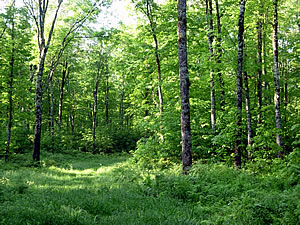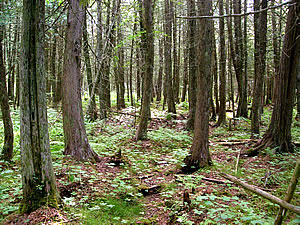Site Description
This vast forested IBA encompasses much of the area owned and managed by the Menominee Indian Tribe of Wisconsin. The glacially influenced landscape features rich, loamy soils, numerous streams, gorges, waterfalls, and rapids. Hemlock, northern hardwoods, white pine, American beech, white cedar, hardwood swamp, and conifer swamp forests are all found here, along with smaller areas of aspen, oak, bogs, open meadows, and beaver ponds. The large, relatively undisturbed cedar swamps are particularly significant.

Menominee Forest, photo by Ryan Brady

Menominee Forest, photo by Ryan Brady
Ornithological Importance
Over a century of sustained-yield management by the Menominee Tribe, which maintains most tree species until biological maturity, has resulted in a diverse, un-even aged forest with a very rich breeding avifauna, particularly for neotropical migrants. This IBA is considered core habitat for black-throated blue warbler and Canada warbler. Other species with large populations include red-shouldered hawk, least flycatcher, veery, wood thrush, Blackburnian warbler, black-throated green warbler, and ovenbird. Cedar swamps host winter wren, hermit thrush, Nashville warbler, and white-throated sparrow, among others.